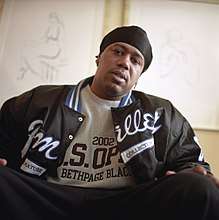Do-rag
A do-rag, durag, or du-rag, also called a wave cap, is a cap typically worn to accelerate the development of waves, braids or dreadlocks in the hair.[1] Durags are also used to keep wave patterns from shifting while sleeping.


History
Durags were originally worn by African American women laborers and slaves in the 19th century. In the 1930s, during the Harlem Renaissance and Great Depression, the durag was used to maintain hairstyles. After the Black Power Movement in the late 1960s, the durag became a fashion statement among African Americans, worn by rappers, athletes and men of all ages. In the 2000s, wearing durags in public lost popularity in certain areas, but maintained its popularity in others. However, because of rappers such as A$AP Ferg and the renewed popularity of waves, they regained their status. Today the durag is worn by all genders as a fashion statement or to maintain hairstyles.
Controversy
Some United States high schools attempted to ban the wearing of durags.[2][3] When John Muir High School in Pasadena, California, banned durags as part of a school dress-code policy, the Black Student Union staged a peaceful walk-out in February 2019.[4] Protesting students contended that school administrators banned the head-wear because of its affiliation with gang culture, although the principal claimed that durags were banned because "of values we have for how we present ourselves at school".
In 2001, the National Football League banned its players from wearing durags and bandanas underneath their helmets.[5]
Etymology
Merriam-Webster placed the earliest usage of "do-rag" in 1968.[6] However, The New York Times claims that the true spelling of the word is "durag," and its popularity began in the 1970s.[7] An alternative etymology claimed that "do-rag" is "dew-rag", and "dew" is a euphemism for sweat.[8]
On June 4, 1966, the Akron Beacon Journal printed "do rag ... a cloth band worn around the forehead as a sweatband or to keep hair in place".[9]
In late 1966, "do rag ... processed hair done up in black rags" appeared in Newsweek.[10]
In popular culture
American singer and bassist Thundercat's album It Is What It Is features the song entitled "Dragonball Durag". The lyrics references the headwear as the title piece to impress women. The durag referenced has a pattern taken from popular Japanese television cartoon Dragon Ball.
Rapper Royce da 5'9" has a song on the 2020 album The Allegory entitled "Rhinestone Doo Rag".
See also
References
- Tom Dalzell (2009), "do-rag", The Routledge Dictionary of Modern American Slang and Unconventional English, Routledge, p. 308, ISBN 978-0-415-37182-7
- Rubio, Karolena (13 December 2018). "Du-Rag Controversy Resolved". raidervoice.com. p. 1. Retrieved 15 July 2019.
- Miller, Rann (20 July 2018). "A Charter School's Explanation for Banning Durags Is Worse Than the Ban". progressive.org. p. 1. Retrieved 15 July 2019.
- Kenney, Tanasia (26 February 2019). "California High School Students Stage Mass Walkout Over Policy Banning Durags". Atlanta Black Star.
- Official NFL Playing Rules, Rule 5: Players, Substitutes, Equipment, General Rules. National Football League. 2011. p. 29.
- "do-rag". Merriam-Webster. Retrieved 6 May 2019.
- Garcia, Sandra E. (14 May 2018). "The Durag, Explained". The New York Times. Retrieved 6 May 2019.
- Preston, Dennis R. (23 March 2005). "Do-Rag (1966)". Lingualist. Retrieved 6 May 2019.
- "Akron Beacon Journal, June 4, 1966".
- "Newsweek, Vol. 68, Oct-Dec 1966, Page 31".
External links
![]()